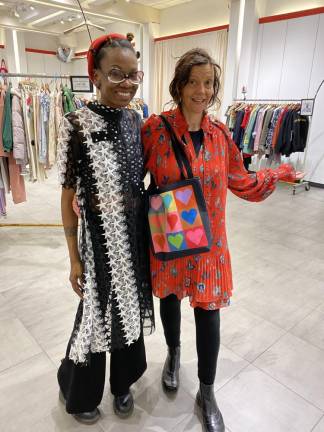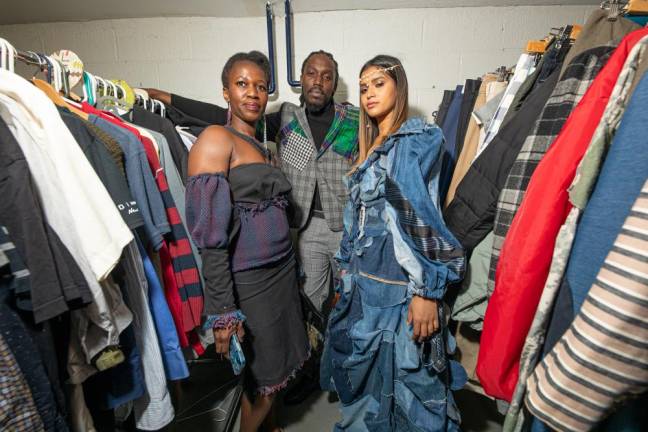Filling All Those Empty Storefronts
Fashion entrepreneur Lesley Ware and Chashama offer model to help boost local business


There are hundreds of vacant storefronts darkening Manhattan streets and stalling our economic recovery. But thanks to Lesley Ware’s passion for fashion there is now one fewer vacancy.
Well, actually, three fewer, as she put vacant storefronts to use over the past year, one after the other, first in Greenwich Village, then Chelsea and now, of all places, inside the Port Authority Bus Terminal.
Ware is a fashion writer and the visionary behind Art to Ware (You get it, right?), a boutique fashion shop that features the works of local designers. For many years, Ware’s vision was just that. A vision. She had neither the means nor the money to open an actual store.
“I had this business plan I had been working on, from 2016,” she recalled the other day. “I never did anything with it. I didn’t have the resources.”
Rents were too damn high, and even if she were willing to take on the risk of a long-term lease it was not clear that landlords were willing to take a risk on her, a young black woman, and her fashion-forward ideas.
Then came the pandemic.
Locked down with her new husband in Ridgewood, Queens, Ware saw an announcement that she says has changed her life and could, if ramped up, help revive the city’s economy and streetscape, city officials said this week.
From Art to Business
The announcement was from a group called Chashama, founded by Anita Durst of the Durst real estate family. Since 1995 the organization has been finding vacant storefronts and other unused real estate for arts group to perform in, helping creators to reach audiences and landlords to keep unrented locations lively.
But last year, in the depths of the pandemic, Chashama identified an additional role, matching aspiring small business people like Ware with storefronts they could use to help launch their businesses.
“There are so many people coming up with new and innovative ideas from being locked in their apartments,” said Durst. So far, Chashama has matched 87 small businesses with 17 retail locations in Manhattan, she said.
That has been a boon for Ware, who took that 2016 business plan off her bookshelf and applied it to popups, first in the Village and then Chelsea before moving into a former Strawberry’s, the teen discount clothier, in the Bus Terminal. “We couldn’t be more different,” she said comparing her offerings with those of the previous tenant.
“A lot of our customers have been women like 50, 60, 70 and even 80,” Ware said, channeling them as saying: “I haven’t bought fun clothes like this in a long time.”
Welcome From Tenants
Ware acknowledges she had some qualms about opening in the bus terminal, with its grimy reputation.
But both official tenants and unofficial residents have been welcoming. One of her neighbors in the bus terminal is a theatrical dance company, The Love Show NYC, also placed in vacant space by Chashama. The dancers and musicians were performing one day to the delight of a man who apparently was living in the terminal.
“He was clapping and gesturing and dancing,” recalled Angela Harriel, director and choreographer of the dance company.
At the end of the performance, the man dug in his pocket for a crumpled dollar and placed it in the red case the dance group used as a donation basket.
The big challenge for Ware and all retailers is that foot traffic has been so curtailed in the pandemic. But lately more commuters have returned to the bus terminal on their way to their offices in the Garment District, Times Square and elsewhere.
“It’s fun to be a part of the reopening of the city,” said Ware, “even though there have been so many twists and turns, ups and downs.”
She says she hopes to remain through the holiday shopping season, but understands that “if it rents, then we have to leave.”
Vacancy Problem
There is no official census of vacant retail space in New York, although everyone agrees it is significantly higher than before the pandemic, when competition from Amazon and other online retailers was already hurting brick and mortar business (like Strawberry’s).
Last summer the Real Estate Board of New York found 300 vacant stores, out of a total of 1,240, in just three Manhattan neighborhoods, around Grand Central and East Midtown, on Madison Avenue and on the Upper East Side.
Not surprisingly, the vacancy problem was most severe in areas that were most dependent on office workers. In Grand Central and Midtown East the vacancy rate was 30 percent, the real estate board reported. On the Upper East Side, it was 20 percent and in residential neighborhoods of Brooklyn and Queens vacancy rates were between 12 and 16 percent.
“There are a lot of empty storefronts right now so there are a lot of opportunities for us,” Durst said.
Public Safety Issue
As the pandemic recedes the situation is slowly improving, but there is a long way to go.
“The storefronts being empty is not just an economic recovery issue,” said Small Business Commissioner Kevin D. Kim. “It also leads to [a] public safety issue which is another top priority of the administration. With fewer people being out in the street to go and shop and walk the streets themselves public safety is jeopardized as well. We know that getting these stores filled with new entrepreneurs. with new ventures is going to be critical for both public safety and economic recovery for the city.”
Kim made said this at a City Council hearing at which Council Member Julie Menin of the Upper East Side pressed him on why the city had not done more through the pandemic to fill vacant storefronts.
“It’s incredibly important to also review what programs were never created,” she said. “Comparing SBS’s response to the pandemic to the approaches taken by other cities shows some areas where SBS failed to to take action. For example, cities across the country, including Seattle and San Francisco developed specific programs to fill empty storefronts to confront storefront vacancies caused by the pandemic. To my knowledge SBS never took action to fill vacant storefronts.”
Kim said the agency, which he has just taken over, had partnered last year with Chashama on their program, which they call Storefront Startup. “That’s a program that we are looking into more to expand and hopefully address the critical need,” Kim said.
Ware and Durst are well ahead of them.
With the recommendation of her current landlord, the Port Authority, Ware is eyeing an expansion to space in another transit hub, the Oculus, next door to the World Trade Center.
Ware acknowledges that her business is not yet ready to succeed on its own, absent the free rent and other support from Chashama. Ironically, she says one thing the Storefront Startup project is doing for her is giving her time and space to get an online business going for the increasing numbers of customers who drop in while passing through town.
“I am going back to Louisiana and we don’t have anything like this there,” she quotes one visitor saying to her. “Do you have an e-commerce store?”
Not yet, she says, but she hopes to be able to have both.
“There are so many people coming up with new and innovative ideas from being locked in their apartments.” Chashama founder Anita Durst